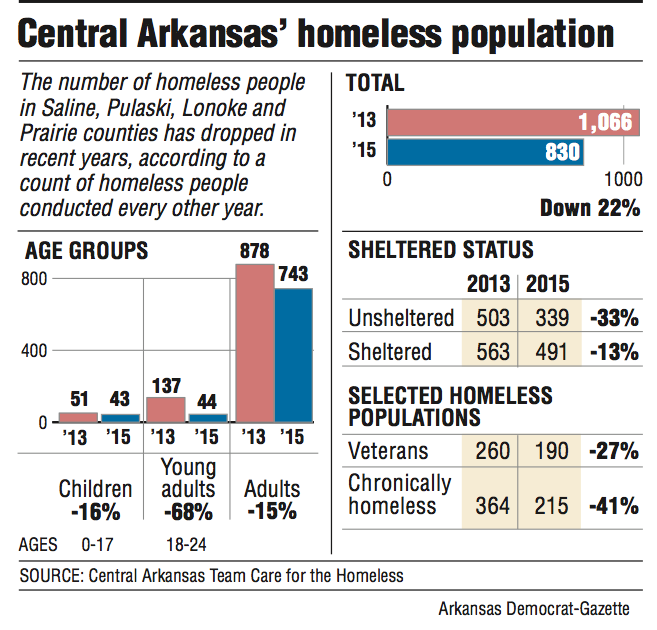The estimated number of homeless people in four central Arkansas counties dropped 22 percent between 2013 and 2015, according to figures released Friday by Central Arkansas Team Care for the Homeless.
Central Arkansas Team Care for the Homeless organizes the count for Pulaski, Saline, Lonoke and Prairie counties each year under the rules and direction of the U.S. Department of Housing and Urban Development.
The figures correspond to counts taken at homeless shelters, resource centers, streets and camps on a single day in January in odd-numbered years. In even-numbered years, the count includes only shelters.
On Jan. 30, 2013, volunteers counted 1,066 homeless people. On Jan. 27, 2015, volunteers counted 830, indicating a 236-person drop.
That drop signals progress in housing and the economy but does not overshadow the need to continue addressing homelessness, officials said Friday.
Each year, volunteers go to the shelters, centers and places where transient people are known to gather. The counts additionally rely on volunteers persuading people to go to resource centers where they can be more easily counted. Incentives might include shoes, socks, hygiene products and/or food, but in the winter, warmth is often the greatest incentive.
HUD selects a day in January with the idea that homeless people are more likely to show up at shelters and resource centers on cold days, making them easier to count, said Ben Goodwin, assistant director of Our House shelter in Little Rock and a member of the Central Arkansas Team Care for the Homeless board.
Temperatures varied a bit for both counts in 2013 and 2015, according to data from the National Centers for Environmental Information.
Temperatures were in the upper 60s in the Little Rock area on Jan. 27 this year, while overnight lows were in the upper 30s. The count was done on a slightly chillier day in 2013, with temperatures in the upper 50s and lows in the mid-30s.
Figures can sometimes be skewed by changes in how HUD defines homelessness, but definitions did not change between 2013 and 2015. In 2012, the department had expanded some requirements for homelessness and decreased others.
But such changes did not greatly skew the drop in homelessness seen from 2009 to 2015, Goodwin said.
He noted that 1,425 people were counted as homeless in 2009, making the 2015 figure a 42 percent drop over the past six years.
Goodwin attributed the drop in homelessness to the expansion of resources, such as increased housing opportunities at River City Ministry in North Little Rock.
Little Rock Mayor Mark Stodola said he is "encouraged by the drop," but expanding housing is the next step for the city to curtail homelessness.
In 2005, the city created a plan that called for the elimination of chronic homelessness in 10 years.
"Chronic homelessness" is defined by HUD to be "an individual or family with a disabling condition who has been continuously homeless for a year or more or has had at least four episodes of homelessness in the past three years."
The number of chronically homeless people counted Jan. 27 in the four-county area was 215.
"It's probably appropriate for us to update that plan and continue progress," Stodola said.
Stodola has been talking with leaders of the city's Jericho Way Resource Center, which opened in 2013, about rehabilitating nearby homes and using them for transitional housing. Right now, the center is open only during the day but provides services for the homeless to help find employment and transition out of homelessness.
Patricia Hill, spokesman for the Central Arkansas Veterans Healthcare System in Little Rock, also credited increased access to temporary housing -- including a partnership with St. Francis House for housing and other supportive services -- for decreasing veterans' homelessness. Supportive services for veterans include physical and mental-health care and employment assistance.
This year, volunteers counted 190 homeless veterans, down from 260 in 2013.
"Our community partners and the influx of 300 vouchers set aside to assist Veterans have made a major impact in our push to house Veterans quickly and permanently," Lynn Hemphill, the health system's homeless-program coordinator, said in a statement to the Arkansas Democrat-Gazette.
The federal government has set a goal to end homelessness of veterans by the end of this year.
In addition to housing, Goodwin said he's seen an uptick in Our House residents' ability to get jobs, particularly in retail services. He said that's because of an improved economy.
But Our House is still full and turning away dozens -- sometimes hundreds -- of people each month, he said.
"In some ways, the numbers surprised me," Goodwin said. "At the [Central Arkansas Team Care for the Homeless] board, we really spent some time analyzing these numbers to make sure they were real, and we feel they are real."
But it was hard to believe them at first because of the continued demand for services for the homeless.
"It doesn't feel like there are fewer people," Goodwin said. "I think maybe one thing is we're doing a better job providing support to help them overcome homelessness, but we still have a lot of demand to deal with on the front end."
Metro on 09/20/2015
